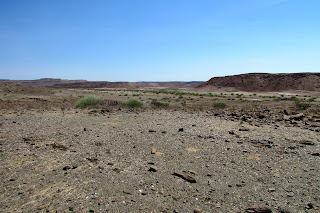Leaving Etosha after three days, we headed south west towards the coast. Between us and the sea were vast expanses of desert and interesting places to visit. We really hated leaving the park but were looking forward to seeing some of the isolated country that Namibia contains. In square miles, Namibia is only marginally larger than the State of Texas but has a population of just over 2 million compared with Texas's 26 million. It contains three deserts - Coastal, Kalahari and Namib - and much of it's coastline is protected in a national park.
She was waiving good by as we passed out of the park.
As we exited the park, it felt strange to be on a paved road and seeing other vehicles. It was still very hot and we learned later that the temperature that day hit almost 45 degrees Celsius (113 F). En route to our next overnight, we stopped to tour an amazing Petrified Forest site. There were petrified rocks everywhere and this one tree was more than 30 meters long (almost 100 feet).
Our home for the next two nights was to be Mowani Mountain Camp which turned out to be one of the most beautiful places we have ever stayed. The camp was built around the boulders of the region and so well integrated into the landscape you really didn't see it until you were literally on top of it.
The lounge and restaurant.
Our "tent". The walls are fabric and the roof thatched.
Incredible landscape.
Linda obviously enjoying it.
To celebrate Linda's retirement, we had a candlelit dinner at a table set by that big rock.
A separate bar on a massive rock facing west. The perfect place for sun downers.
Over drinks with the manager, I made a strong case that he needed someone like me to manage that bar and live there permanently. He said he'd get back to me -- I'm still waiting to hear.
We had a rest day so we signed up for an early morning game drive. Since it was the low season, it was just us and Frederich, the guide, informed us he had heard about elephant sightings, so off we went. We passed through several villages and drove up a dry river bed until we started seeing elephant tracks.
And there they were.
This young guy was very curious about the vehicle.
It was a pretty large herd and included a few young ones. They seemed oblivious to our presence as they ate from the trees. They were moving up the riverbed and we followed along for quite awhile.
The next day, we headed out to see the rock art at Twyfelfontein, a UNESCO Heritage Site that contains one of the largest collections of rock art in Africa. The area has been inhabited by Bushmen for thousands of years and the rock art, most of which dates back 2000 - 2500 years, was intended to show where animals and water was located. There are close to 2500 different rock drawings in the area so we only saw a fraction of them.
This is actually a map. The indentations in the circle signify water holes.
Note the drawing of the seal. We are still a good distance from the coast but the Bushmen ranged over a large area.
An ostrich. Note the various positions of the neck and head.
Since we were "in the neighborhood", we decided to drive to the Doros Meteor Crater. We could see it on the map but this being Africa, there were no signs indicating where it was. Oswald came equipped with a GPS loaded with Tracks 4 Africa which did an excellent job preventing us from getting lost. We hit the end of the main road, engaged the low range in 4WD and off we went. There were a lot of tracks going off in various directions but the GPS kept us headed generally in the right direction.
Desolate country.
We got to where the GPS said the crater should be. This rock was unlike any of the others in the area but we don't know if it's a meteor or not.
Signage
We went from our favorite lodge to what became our favorite campsite, Madisa. It's remote and we were the only ones there. Given its location, the local community has obviously worked very hard to create an oasis in some pretty tough country.
Every campsite has wonderful shade,
great cooking and cleaning facilities,
and amazing showers, open to the sky.
Mud walls
Even a vessel sink.
The bonus was an almost full moon over camp.
Until next time . . .



















































































